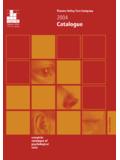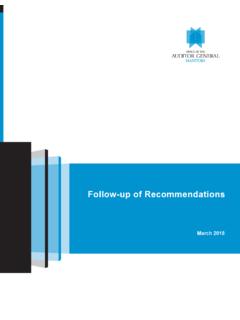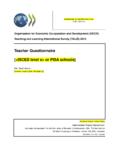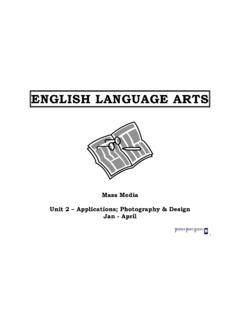Transcription of Introductory essay by Marvin Heiferman for the …
1 Page 1 2001 Marvin Heiferman Introductory essay by Marvin Heiferman for the exhibition of RAINING POPCORN at the Faulconer Gallery, Grinnell College 2001 Marvin Heiferman . Serious Thoughts are Popping Up. In Sandy Skoglund: Raining Popcorn. Grinnell, Iowa: Faulconer Gallery, Grinnell College, 2001. 2001 Marvin Heiferman . Used with permission It was more than a quarter century ago that American artists began to turn to photography with excitement and in growing numbers acknowledging that it was the medium best suited to make sense out of the complexity of late 20th-century existence.
2 Some artists made deadpan photographic images to document their conceptual investigations or to comment on the quirkier intersections of art and life. Others appropriated everyday commercial imagery, living under the skin of popular culture s pictures in order to understand how the photographs that claimed to represent reality had come to be as engaging as reality itself. Still another option, one pioneered by artists like Sandy Skoglund, was to explore photography s power to redefine reality by learning how to fabricate compelling fantasies and illusions.
3 That practice which came to be known as tableaux or directorial photography demanded a knack for storytelling, a sense of style, and a repertoire of convincing technical skills. And from her earliest major installations and photographic works to her most recent work, Raining Popcorn (2001), Skoglund has repeatedly proven her mastery of those skills. For two decades, she s been a canny pop-culture showman, producing appealing, yet ultimately disturbing artworks that never fail to attract viewer attention. It's hard to be blas when confronted with Skoglund s signature, over-the-top psychodramas.
4 And hard not to shake your head in disbelief or crack a smile when you find yourself, literally or figuratively, in a corner of the world where everything is covered in uncooked chopped meat, raisins, or jelly beans. Skoglund s aggressive disregard of conventional good taste and high art seriousness often reads as humor and lightness in an art world prone to self-importance and pretension. But ultimately, behind the sometimes jokey and always raucous fa ades of her sculptural installations and photographic images, it is Skoglund s intention to trigger discomfort and self-reflection.
5 It is the darker side of her imagination that gives the work its edge and depth, that keeps it from teetering into gimmickry and theme park insincerity. No matter how seductive or loopy her materials, imagery, or implied narratives might get, Skoglund is relentlessly focused on the production of metaphors that reflect human fear and vulnerability. Page 2 2001 Marvin Heiferman Behind the manic, matching props and the optical buzz of carefully calibrated color coordination lie more subtle, somber messages. Skoglund almost challenges her audience to wade through the distraction of surface patterns and to accustom themselves to the visual din to get to the essence of the work.
6 And for those who do, something odd happens. A surprising calm settles over the work s hyperactivity. And Skoglund s lower-keyed, but more powerful juxtapositions and contradictions emerge: Humor co-exists with anxiety, the human with the animal world, and the banal with the apocalyptic. The work simmers down and reminds viewers of their smallness in a big, over-determined world where consumer culture, nature, science, and their interior gyroscopes regularly spin out of control. Control lies at the core of Skoglund s work. Each project presents new challenges the learning curve to master idiosyncratic materials, the logistics of mass production, long stretches of repetitive work, and repeated tests of willpower.
7 From the conception of projects through extended periods of labor-intensive, factory-like production, to the final installation and photography, nothing is left to chance. Fortunately, Skoglund relishes that sort of challenge; she s always derived pleasure and satisfaction from hard work. To hear Skoglund reflect back on the joy and tedium she experienced on her earliest jobs decorating cakes, hour after hour, on the night shift at a commercial bakery; selling shoes, perfume and even hot dogs at Disneyland sheds biographical light on the content, process, and unforgiving intensity of her work.
8 Harnessing her skill and determination to create images for a world in which logic no longer rules, Skoglund aligns herself with artists and writers whose subject matter is the irrationality of modern life. Sigmund Freud, in a 1919 essay , The Uncanny, was the first to describe the unsettling response one feels when confronted with situations that are simultaneously both familiar and strange, that trigger a kind of amazement, a sense of shock, and a thrill. That kind of exquisite discomfort inspired the earliest surrealist artists who responded to the horrors of World War I, and others in subsequent decades who responded to the dislocations of daily life by making artworks in which interior and exterior realities were experienced simultaneously.
9 Page 3 2001 Marvin Heiferman Skoglund s work extends that tradition. Her work shares the theatrical flair of Salvatore Dali s hallucinogenic tableaux, the charmingly domestic preposterousness of Rene Magritte s paintings and sculptures, and the fancifulness of Man Ray s photographs. Ironically given Skoglund s intense study and learned facility there s something about her subject matter, choice of materials, and compulsive work habits that call to mind yet another group of artists self-taught or folk artists.
10 But while Skoglund might share their offbeat sensibility, unshakable sincerity, and transcendent focus, her visions are firmly rooted in her own cultural self-consciousness. From commercial photography, Skoglund has learned to meticulously craft the aura of perfection that transforms mundane realities into convincing illusions. She draws liberally from the conventions of science fiction and horror films, and the display techniques of natural history museums and store windows. Dense as the network of sources for her work might be, Skoglund is reluctant to articulate specific meanings for her imagery.





